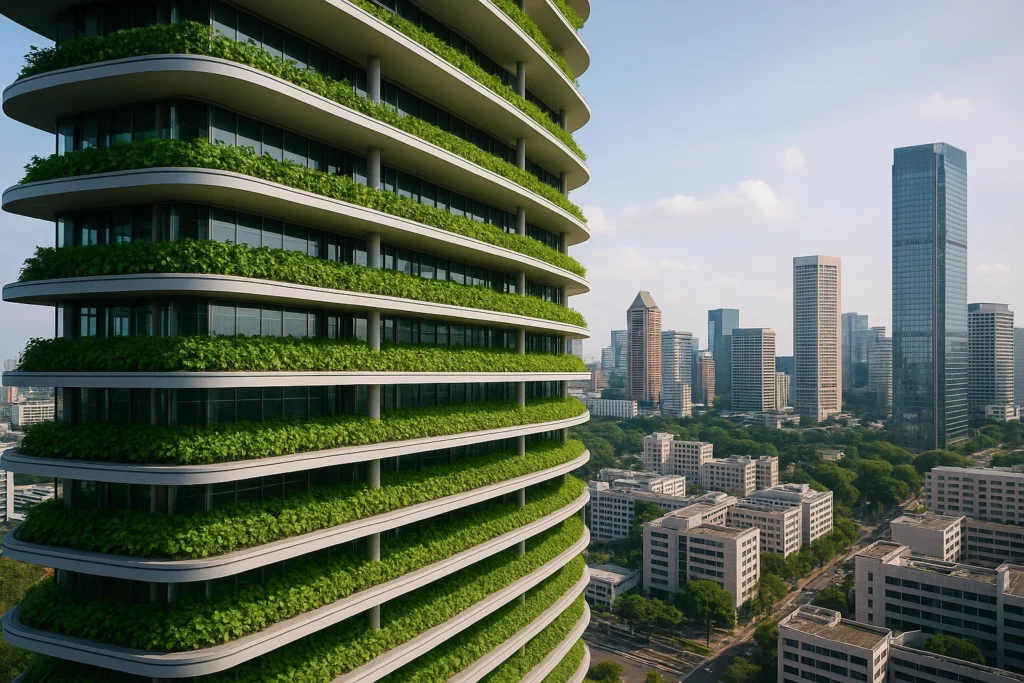The Rise of Agriculture’s Skyscraper Era
In the heart of Singapore’s bustling financial district, a gleaming 38-story tower stands as a beacon of agricultural innovation. Unlike the surrounding office buildings, this structure’s glass walls reveal something extraordinary – lush green vegetation growing on every floor. This is ComCrop, Asia’s tallest vertical farm, producing over 5 tons of fresh produce weekly for the city-state’s restaurants and supermarkets.
Across the globe in an abandoned Brooklyn warehouse, a different kind of farming revolution is underway. Bowery Farming’s indoor operation yields 100 times more produce per square foot than traditional agriculture, using artificial intelligence to monitor and adjust growing conditions with precision impossible in outdoor fields. Meanwhile, in Tokyo, the Spread Co. facility harvests 30,000 heads of lettuce daily from what was once an empty industrial complex.
These pioneering operations represent the vanguard of vertical farming – a radical reimagining of agriculture that could solve some of humanity’s most pressing food security challenges. As urban populations swell and climate change threatens traditional farming, these high-tech growing systems offer a compelling vision for how cities might feed themselves in the coming decades.
The Urgent Need for Agricultural Innovation
Population Pressures and Urban Expansion
The numbers paint a stark picture of our global food challenge:
- By 2050, the world population will reach 9.7 billion, with nearly 70% living in urban areas
- Urban land area is expected to triple between 2000 and 2030
- Traditional agriculture already uses 50% of the planet’s vegetated land
- Food production must increase by 70% to meet future demand
Dr. Dickson Despommier, the Columbia University professor who first popularized vertical farming concepts, explains: “We’re running out of arable land at precisely the moment we need more. Vertical farming allows us to grow up rather than out, potentially producing food in the same places where most people will soon live – cities.”
Climate Change Threats to Traditional Agriculture
Conventional farming faces unprecedented challenges from climate disruption:
- Rising temperatures are reducing yields of staple crops like wheat and corn
- Unpredictable weather patterns increase risk of crop failures
- Droughts threaten water-intensive agriculture in key growing regions
- Soil degradation affects 33% of the Earth’s land surface
“The beauty of vertical farming,” says Dr. Despommier, “is that it’s largely insulated from these climate threats. Indoor environments protect crops from extreme weather, droughts, and pests.”
How Vertical Farming Works: The Science Behind Soil-Free Agriculture
Hydroponic and Aeroponic Growing Systems
Modern vertical farms utilize two primary soil-free growing techniques:
Hydroponics
- Plants grow in nutrient-rich water solutions
- Roots may be supported by inert media like perlite or coconut coir
- Water is continuously recirculated, using up to 95% less than field farming
- Ideal for leafy greens, herbs, and some fruits
Aeroponics
- Plant roots dangle in air and are periodically misted with nutrients
- Uses 90% less water than conventional agriculture
- Higher oxygen exposure can accelerate growth rates
- NASA has experimented with aeroponics for space missions
Precision Lighting Technology
Advanced LED systems have revolutionized indoor farming:
- Custom “light recipes” optimize growth for different crops
- Blue wavelengths promote leafy growth
- Red wavelengths encourage flowering and fruiting
- Energy efficiency has improved 50% in last 5 years
- Some systems now use 60% less power than early models
“Today’s LEDs are so efficient that energy costs are no longer the barrier they once were,” explains Nate Storey, co-founder of Plenty. “We’ve reached the point where vertical farming can compete with traditional produce on price.”
Climate Control and Automation
Sophisticated environmental management systems maintain ideal conditions:
- Temperature and humidity precisely regulated
- CO2 levels optimized for photosynthesis
- AI monitors plant health and adjusts conditions in real-time
- Robotic systems handle planting, maintenance, and harvesting
- Sensors track thousands of data points continuously
At AeroFarms’ New Jersey facility, machine learning algorithms analyze over 130,000 data points daily to optimize growing conditions for various crops.
Global Leaders in Vertical Farming Innovation
Singapore: The Vertical Farming Laboratory
Facing extreme land constraints (only 1% of land available for agriculture) and importing 90% of its food, Singapore has become a global testbed for vertical farming innovation.
Key Players:
- Sustenir Agriculture – Grows tropical fruits like strawberries indoors
- Sky Greens – World’s first commercial vertical farm using rotating tiers
- ComCrop – Rooftop and vertical farming pioneer supplying local retailers
Government initiatives like the “30 by 30” program aim to produce 30% of nutritional needs locally by 2030, with vertical farming playing a central role.
United States: From Niche to Mainstream
The U.S. vertical farming sector has grown from experimental projects to supplying major grocery chains:
- Plenty – Operates 500,000 sq ft of vertical farms supplying Whole Foods
- Bowery Farming – Provides greens to 1,100 stores including Walmart and Amazon Fresh
- AeroFarms – Built the world’s largest vertical farm in Virginia (250,000 sq ft)
Investment has surged, with $1.2 billion flowing into U.S. vertical farming startups in 2022 alone.
Japan: High-Tech Solutions for an Aging Farming Population
With the average farmer age at 67 and farmland contaminated in some regions, Japan has aggressively adopted vertical farming:
- Spread Co. – Fully automated facility produces 30,000 heads of lettuce daily
- Mirai Group – Supplies 3% of Tokyo’s lettuce from indoor farms
- Toshiba – Repurposed semiconductor clean rooms for ultra-sanitary vegetable production
The Japanese government has invested over $200 million in vertical farming research and development.
The Economic and Environmental Benefits
Resource Efficiency
Vertical farming offers dramatic improvements in resource use:
- Water: Uses 70-95% less than conventional agriculture
- Land: Produces equivalent yields on 1% of the land area
- Pesticides: Eliminates need for chemical pesticides
- Transportation: Local production reduces food miles
A study by the University of Michigan found that lettuce grown in vertical farms:
- Requires 82% less water
- Uses 67% less energy (when renewable power is used)
- Produces 90% fewer emissions
Year-Round Production
Unlike seasonal field farming, vertical farms offer:
- Consistent yields regardless of weather
- Multiple harvests per year (up to 15 for some leafy greens)
- Predictable supply for retailers and restaurants
- Stable pricing unaffected by seasonal fluctuations
Urban Revitalization
Vertical farms are breathing new life into urban spaces:
- Repurposing abandoned warehouses and factories
- Creating jobs in economically depressed areas
- Improving food access in “food desert” neighborhoods
- Generating fresh produce within hours of consumption
Challenges and Limitations
High Capital Costs
Startup expenses remain significant:
- $50-$100 per square foot for basic systems
- $200+ per square foot for fully automated facilities
- Energy costs can be substantial without renewable power
- ROI timelines of 5-7 years deter some investors
Energy Demands
While LED efficiency has improved:
- Lighting still accounts for 60-70% of operating costs
- Some facilities use as much electricity as small towns
- Renewable energy integration is critical for sustainability
Crop Limitations
Current economic viability is limited to:
- Leafy greens (lettuce, kale, spinach)
- Herbs (basil, mint, cilantro)
- Some fruits (strawberries, cherry tomatoes)
- Not yet practical for staple crops (wheat, rice, corn)
Consumer Perceptions
Some challenges remain in market acceptance:
- “Too perfect” appearance raises suspicions
- Concerns about “artificial” growing conditions
- Preference for “dirty” traditionally grown produce
- Need for clearer labeling and education
The Future of Vertical Farming
Next-Generation Technologies
Emerging innovations promise to expand possibilities:
- Solar-powered vertical farms – Integrating photovoltaic glass
- Aquaponics integration – Combining fish and plant production
- Genetic optimization – Breeding crops specifically for vertical farming
- Alternative energy – Using food waste for biogas production
Architectural Integration
“Agritecture” is becoming a design priority:
- Mixed-use buildings with integrated farms
- Rooftop greenhouses on residential towers
- Underground farming in unused urban spaces
- Vertical farm “skins” on office buildings
Policy Support and Investment
Governments are increasingly supporting the sector:
- USDA grants for urban agriculture projects
- Singapore’s 30×30 initiative
- European Green Deal funding
- Tax incentives for sustainable food production
Vertical Farming’s Role in the Future Food System
Experts predict vertical farming will complement rather than replace traditional agriculture:
- Urban centers will rely increasingly on local vertical farms
- Rural areas will continue field production of staple crops
- Hybrid models may emerge (vertical farming for greens, fields for grains)
- Developing nations may leapfrog to vertical farming in rapidly growing cities
As AeroFarms CEO David Rosenberg notes: “We’re not trying to replace the entire agricultural system. We’re creating a new piece of the puzzle that makes the whole system more resilient, sustainable, and responsive to 21st century challenges.”
The vertical farming revolution represents more than just a technological shift – it’s a fundamental rethinking of how and where we grow our food. As cities continue to expand and climate challenges intensify, these skyward-growing solutions may well determine whether we can feed the urbanized world of tomorrow.




kkqs2p